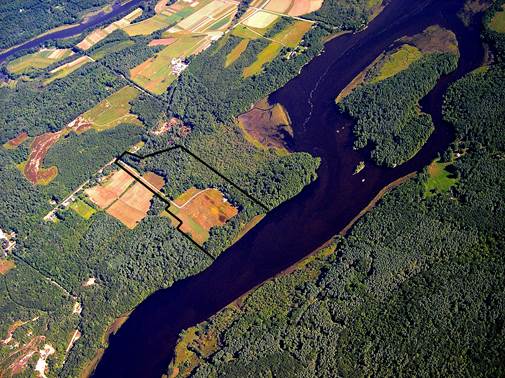 |
|||||||||||||||


Conservation and Stewardship
Archaeology & Conservation Easement Finalized
Dresden Maine
Dresden Falls Conservation Easement FinalizedAfter about six years effort the final Dresden Falls or Houdlette archaeology parcel was transferred to The Archaeological Conservancy [TAC] on September 25th. Friends of Merrymeeting Bay [FOMB] led efforts to protect the property and retained a 4 acre section of the archaeological and high value habitat site until a conservation easement could be completed for the entire approximately 31 acres most of which was conveyed to TAC a couple of years ago. This site is considered the most important prehistoric archaeological site in Maine and also has the largest stand of the rare plant spongy arrowhead seen in the Bay area.
Between 4,500 and 9,000 years ago, when river levels were lower than now and rising, there probably was a major rapids or waterfall at Goodwin Narrows across from the northern end of Little Swan Island in the Kennebec. With the falls hampering anadromous fish runs; native Americans developed a major seasonal fishing camp on this adjacent site. The Dresden site is reported to be the largest and most intensively occupied site of its age known in the State of Maine, and has produced more stone tools than any other Early to Middle Archaic site in New England.
The 4 acre section FOMB retained until now contains the high ground overlooking portions of the Dresden site with confirmed intact prehistoric archaeological features. This section also contains confirmed intact 18th century archaeological features, and historical maps show several structures on the property at the time of the Revolutionary War. Had FOMB not intervened, the site would have been developed into an 8 home subdivision.
While The Archaeological Conservancy will own the entire property, the FOMB easement protects conservation and archaeological values. Additionally, the Maine Historic Preservation Commission holds a Preservation Agreement on about 60% of the property. Two grants from the Land for Maine’s Future program helped the acquisition and the parcel is open to non-motorized use by the public. No disturbance of the land surface is permitted.
“Protecting this property was a long-term goal for FOMB and a major accomplishment”, said Ed Friedman, Chairman of FOMB. “With protection, substantial benefits accrue for Bay communities, state and federal agencies and anyone with wildlife and archaeological interests. The Archaeological Conservancy, Maine Historic Preservation Commission, Land for Maine’s Future and individual donors and grantors all worked together with FOMB to make this possible.”
Photo: Point of View Helicopter Services
Watercolors by
Sarah Stapler
Sarah Stapler
